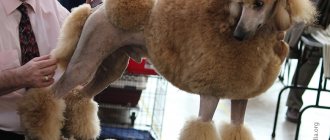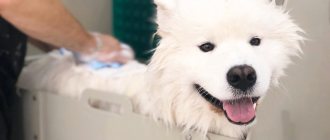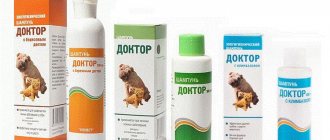What is grooming for dogs
Grooming a royal poodle
Grooming (from the English “groom” - to clean, care) is a set of procedures for caring for the appearance of pets.
Professional services are provided by trained specialists - groomers who work in salons and know everything about grooming procedures, including the name of this or that animal haircut. The grooming goals of four-legged owners are completely different: some prepare their pets for an exhibition, others want to have a neat pet in the house, others need extravagant modifications to obtain aesthetic pleasure from the dog’s exterior.
Grooming table
If you choose the services of a professional groomer, in his office you will certainly see a grooming table, folding or stationary. The table has an anti-slip coating, so even the most obstinate pet will not fall off it. In addition, it is much easier to remove wool from it than from household furniture.
The tables have special tripods to which the animal can be tied if it does not allow manipulation. Most tables have the ability to adjust the height: tidying up the coat of a Spitz and a Royal Poodle at the same table height is very difficult. Some more advanced models also have lighting, which will help illuminate the “field of activity” as much as possible, which will greatly simplify the care procedure.
Types of grooming
Dog grooming is divided into three types, which include many procedures.
Hygienic grooming
Mandatory procedures that must be carried out regularly for every dog (can be done both in the salon and at home):
- Grooming – bathing and drying the animal, combing the coat to remove dead hair, untangling tangles, trimming excessively long hair, including on the limbs – between the toes and pads, trimming.
- Eye care - rinsing with special solutions to remove secretions.
- Dental care – cleaning, removing plaque.
- Nail care - trimming, filing.
- Ear sanitation – cleansing of sulfur secretions with special solutions.
- Cleaning the paraanal glands - removing secretion from the glands in order to prevent blockage and the formation of inflammatory processes.
- Treatment against ectoparasites.
Note! During the work process, the dog groomer changes combs with different thicknesses, densities and lengths of teeth, taking into account the characteristics of the coat on different parts of the body.
Aesthetic
Allows you to radically change the appearance and create a unique image of the dog. Spa services, creative haircuts, wool dyeing, manicure, body art, tattooing, teeth whitening, rhinestone decoration, etc. are used.
Exhibition
In this case, the procedures are carried out according to the requirements of the breed. By creating an exhibition version, the groomer maximally emphasizes the advantages of the four-legged exterior.
Home grooming
Those who choose grooming at home usually carry out all manipulations on ordinary kitchen or coffee tables, fixing their pets with the help of other people. This is not the most successful method, which is dangerous not only for the person holding the animal, but also for the pet itself, which can easily be injured by falling from such a “table”.
When carrying out all procedures, it is necessary to use professional tools, because “human” scissors and combs, even in skillful hands, can cause harm to the pet’s health.
Basic groomer case for work
Each pet requires an individual approach in matters of grooming, and if caring for dogs at home requires a minimum of tools, then the kit of a professional master has a wide enough range to work with a wide variety of animals.
Groomer Tools
Grooming Tools
Tools used for grooming include:
- Combs. It is preferable to use combs made of high-quality metal with cone-shaped teeth, which do not injure the skin and do not cause pain when combing the dog’s fur. When starting work, groomers use wide-toothed combs to help remove tangles. Combs with rotating teeth can straighten matted wool; combs with combined two-level teeth also do a good job of this task. The procedure is completed using fine-toothed combs.
- Massage brushes are designed for long-haired dog breeds and pets with medium-length hair. Brushes with natural bristles, like massage brushes, are good for removing shedding hair not only from dogs, but also from cats.
- Pukhoderki. The tool is convenient when working with tangled and unruly hair, especially in long-haired dog breeds. Slicker brushes have elastic metal teeth that allow you to effectively comb out thin, sparse or curly hair.
- Furminator. Used to reduce the intensity of shedding. When combing out dead hairs of the undercoat, the guard hairs are not affected. The tool can be mechanical or electric with a massage function.
- Scissors. A groomer may have a variety of dog grooming scissors in his arsenal: with straight or curved blades, with straight or rounded tips. However, the basic tool is regular scissors with straight blades. To groom dogs, it is enough to have two pairs of such scissors, one pair of thinning scissors (for thinning and giving the coat a neat shape) and another pair with rounded ends (for cutting in delicate places so as not to injure the animal).
- Stripping knives. A procedure called stripping is intended for wire-haired dog breeds in which the shedding process does not occur and dead hairs remain in the coat. Plucking hair gives dogs a well-groomed appearance and is simply necessary for their health. For the procedure, knives of different sizes and with different frequencies of teeth are used. The tool is designed in such a way that it makes it easier to grab hairs and pluck them without cutting, without damaging the skin.
- Trimmers. Anyone who grooms dogs with a special electric or mechanical (manual) clipper is probably satisfied, since such tools save time and nerves. Of course, the electric models of this dog grooming equipment are more productive, which is why their cost is quite high. Groomers use professional clippers, while amateur ones are suitable for home care.
- Hairdryers. To dry dogs, groomers use professional compressor hair dryers with a power of 1200-2000 W with a protective mesh to prevent hair from getting inside.
Nail trimming tools
Nail clippers are available in different sizes, so there is no difficulty in choosing a tool for any dog. The most popular is a nail cutter in the form of nippers, which shortens the claw without squeezing it. The guillotine nail clipper is only suitable for dogs with a calm temperament, since the claw from the holding hole cannot always be quickly removed. After shortening, the edge of the claws is trimmed with a nail file.
Note! There is a manicure tool similar to an electric file with several speeds and different attachments, called a grinder.
Dental care products
To clean dogs' teeth, manufacturers produce a variety of accessories: toothbrushes, self-cleaning products, tools for removing tartar, etc. Dogs' oral cavity is cleaned using toothpaste and gel. Since dental diseases are quite common in dogs, owners need to carefully monitor the condition of their pets’ teeth.
Cosmetical tools
The groomer's basic kit necessarily contains disinfectants, hemostatic agents, drops for treating eyes and ears to prevent their diseases, flea and tick remedies, anthelmintics, shampoo, conditioner, cosmetic products for styling, deodorant sprays, ear powder and etc.
The process of a groomer working in a salon
Grooming training
It is impossible to engage in grooming just like that, without any training. Firstly, minimal knowledge about the anatomy of animals, the structure of their fur, claws, ears is necessary at a minimum in order not to harm the four-legged client. Secondly, groomers are usually taught to calm pets who are nervous during grooming procedures, so taking appropriate courses is also necessary to preserve the health of the groomer himself. The grooming school traditionally trains specialists. The courses teach the correct choice of tools, teach the basics of animal psychology, talk about the latest grooming trends (such as dyeing dog fur), and demonstrate certain haircut options. It is worth noting that there are courses for home groomers aimed at working with a specific breed of dog or cat (after all, care depends on the size of the pet, the length and thickness of its fur, and the character inherent in certain pets). Of course, during the courses they also talk about the choice of cosmetics, without which proper care of the skin and coat of dogs and cats is impossible.
Therefore, if you decide to become a professional groomer or want to learn how to properly care for your own pet, you must take specialized courses. In the first case, they will give you a certificate, without which you will not be able to engage in professional activities in this field. In the second - professional knowledge about how to treat your pet during care.
Main stages of grooming procedures
Dog grooming consists of a number of successive stages:
- The first stage is washing. Before water procedures, the animal must be placed on a rubber mat, which will prevent its paws from slipping in the bathtub. It is necessary to wash your pet exclusively with warm water, gradually applying and distributing the shampoo throughout the entire coat. Do not allow soap suds to get into your ears, eyes or mouth. At the end of the procedure, the coat should be thoroughly rinsed and the dog should be wrapped in a towel to prevent freezing.
- The second stage is drying. This procedure involves working with a powerful hair dryer. Dogs with long hair are combed with a slicker brush, directing the air flow along the hair growth.
- The third stage is trimming the claws. The claws should be shortened extremely carefully, trying not to touch a blood vessel. If damage does occur, then you need to use hemostatic drugs.
- The fourth stage is combing the fur. The choice of brushing tools depends on the type of coat, its length and condition. This important preparatory step is done before cutting.
- The fifth stage is haircut. To trim the coat, the groomer uses scissors and clippers, depending on breed standards.
Consequences of improper animal care
Many people believe that such care is animal cruelty. However, pets require it as a way to maintain hygiene and a neat appearance. Lack of proper animal care can lead to the following consequences:
- Felted wool, tangles . It threatens the appearance of parasites, dandruff, itching and irritation, and interferes with free movement.
- Shedding. You will have to get rid of wool on carpets, furniture and clothes all year round.
- Overheat. Due to impaired heat exchange, there is a threat of “sunstroke”.
- Allergy. Cat allergens are among the most dangerous.
- Wool in the gastrointestinal tract. Interferes with normal digestion, can block the intestinal lumen and lead to obstruction.
Which dogs need haircuts and which don't?
Those owners who have a question about the name of dog grooming, when groomers cut the hair in the tail area, genitals and between the paw pads, should know that this is a hygienic procedure and is necessary for all pets, without exception, to maintain cleanliness.
For long-haired and especially show dogs, a classic haircut is an important aspect of their life. Giving a stylish haircut not only makes your dog look sophisticated, but also meets the standard of its breed. Its main task is to emphasize the advantages, hiding the disadvantages.
Note! Smooth-haired dog breeds do not need haircuts. Their short coat, close to the body, looks great without much effort from the owners.
Well-groomed Pekingese after grooming procedures
Every dog owner knows how important it is to provide care and attention to their four-legged friend. Any pet needs grooming, regardless of breed. Grooming procedures should be regular for dogs of decorative breeds, since the trump card of these dogs is beauty.
What do you need? Combs
Let's move on to what grooming tools exist. The most primitive and widespread, even among non-professionals, are brushes for combing out the undercoat, also known as slickers. These combs are suitable for combing out tangles in pets’ fur.
Olong brushes are suitable for constant use by owners of long-haired dogs, which have to be combed almost daily.
Professionals use pintail combs similar to human ones (with a long, needle-shaped handle) to create hairstyles for their pets (grooming of dogs is a prerequisite for the participation of a four-legged animal in an exhibition, so owners who want to attract attention to their pet invent the most incredible hairstyles for their companions) .
Grooming Tools
To care for animals you will need:
- Hair trimmer (minimum 3-4 attachments).
- Scissors (regular, curved, special for cutting hair on paws and face, thinning).
- Rake for removing matted fur.
- Nail clippers (for cats, decorative dogs and large animals).
- Stripping knife.
- Furminator.
The number of tool units depends on the number of salon employees. Additionally you will need:
- Tool bag.
- Smock.
- Apron.
- Gloves.
The minimum cost for the tool will be about 25,000 rubles. High-quality hairdressing accessories are a prerequisite for work. It is dangerous to use cheap analogues. Plus they wear out quickly.
When did grooming appear?
The grooming procedure began in ancient times. Horse owners carefully looked after their pets. Care consisted of constant combing, mane care, haircut, brushing teeth, and other hygiene procedures. Long-haired breeds needed careful care. Particular care was taken for poodles that needed extra attention from their owners. With the advent of the 20th century, the popularity of grooming has greatly increased. Today it is impossible to imagine almost any pet without grooming procedures.
What qualities does a groomer need?
When choosing a groomer, you should be guided by the specialist’s character and experience. After all, your pet will be uncomfortable with an amateur. Grooming is a rather complex profession that requires care. The difficulty is associated with different reactions of pets to people engaged in similar procedures, even aggression. The groomer needs to be patient to win over the animal.
It is important to remember: when entrusting your pet to the professionals of a grooming salon, keep in mind that there is a team of specially trained people who are familiar with the rules of caring for different breeds of pets.
Procedures related to hygiene in the home environment must begin with studying their correct organization for specific breeds of animals. Start by purchasing special tools - scissors or clippers, combs or slickers, and other accessories. You can’t do without a quality detergent. Each animal needs its own hygiene products.
To comb your pet, use a comb in combination with a slicker brush. After fully combing the fur and removing tangles, you can begin washing the animal. Wet wool can be cut. They start with the muzzle area, then deal with the ears, eyes, moving on to other areas, from the paws to the armpits. The animal should be comfortable while being groomed.











